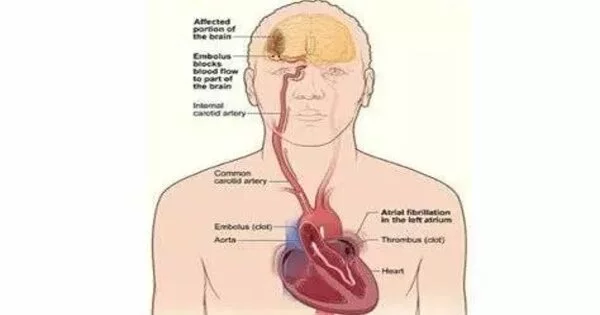A common cardiac rhythm disease characterized by irregular and typically fast heartbeats is atrial fibrillation (AFib). It can dramatically raise the risk of stroke because blood clots can develop in the upper chambers of the heart (atria) and travel to the brain, producing a blockage in a blood vessel.
Researchers have found a novel method for detecting people who are at risk of an irregular heartbeat known as “atrial fibrillation.” While not fatal, the syndrome raises people’s chances of having a transient ischemic attack (TIA) or stroke by up to five times.
A recent study has discovered four distinct characteristics that can predict whether people will develop atrial fibrillation. These include advanced age, increased diastolic blood pressure, and issues with coordination and function of the upper left chamber of the heart. The researchers then developed a simple tool for doctors to use in practice to identify patients at high risk. They anticipate that this may aid in the diagnosis and treatment of more people, lowering their risk of future strokes.
Researchers at the University of East Anglia have devised a novel method for detecting people who are at risk of an irregular heartbeat known as “atrial fibrillation.” While not fatal, the syndrome raises people’s chances of having a transient ischemic attack (TIA) or stroke by up to five times.
We identified four parameters associated with the development of atrial fibrillation that were consistently present in patients with this arrhythmia. We then created a model that can predict who would develop atrial fibrillation in the next three years, putting them at a higher risk of having another stroke.
Prof Vassilios Vassiliou
According to a new study, four distinct characteristics can predict which patients will develop atrial fibrillation. These include advanced age, increased diastolic blood pressure, and issues with coordination and function of the upper left chamber of the heart. The researchers then developed a simple tool for doctors to use in practice to identify patients at high risk. They anticipate that this may aid in the diagnosis and treatment of more people, lowering their risk of future strokes.
Prof Vassilios Vassiliou of the University of East Anglia’s Norwich Medical School and Honorary Consultant Cardiologist at the Norfolk and Norwich University Hospital, who led the study, said, “Identifying who is at high risk and more likely to develop atrial fibrillation is very important.”
“This is because it requires specific treatment with anticoagulants, commonly known as blood thinners, to reduce the risk of future strokes. Patients who have had a stroke usually undergo multiple investigations to determine the cause of the stroke, as this can influence the treatment they receive long-term. These investigations include prolonged monitoring of the heart rhythm with a small implantable device called a loop recorder, and an ultrasound of the heart, called an echocardiogram.”

The researchers gathered information from 323 individuals treated at Cambridge University Hospitals NHS Foundation Trust in the East of England who experienced a stroke with no known cause, a condition known as Embolic Stroke of Undetermined Source. They looked at medical records as well as data from continuous cardiac rhythm monitoring. They also looked through their echocardiograms.
Professor Vassiliou commented: “We determined how many of these patients were found to have atrial fibrillation up to three years following their stroke, and went on to perform a thorough assessment to identify if there are specific parameters that are connected with atrial fibrillation identification.”
“We identified four parameters associated with the development of atrial fibrillation that were consistently present in patients with this arrhythmia. We then created a model that can predict who would develop atrial fibrillation in the next three years, putting them at a higher risk of having another stroke.”
“This is a very easy tool that any doctor can use in clinical practice,” he said. “And it can potentially help doctors provide more targeted and effective treatment to these patients, ultimately aiming to highlight the people at higher risk of this arrhythmia that can benefit from prolonged heart rhythm monitoring and earlier anticoagulation to prevent a future stroke.”
















